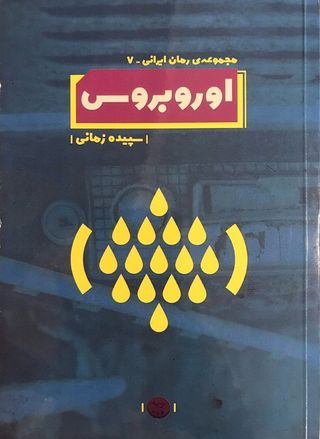
Ouroboros
Ouroboros is a 146 page novel in 15 chapters by Sepideh Zamani. The book was published by Mehr Publications in 2017 in London.
The story involves a family from Tabriz who, because of the political activities of the father, are forced to go into exile to Mazandaran in order to escape the political conflict in Tabriz.The story takes place during a period of Iran’s history when the feudal system was dominant in some parts of Iran, with the lives of peasants subject to changes according to the whims and moods of the ruling class.
The title is taken from Greek mythology. Ouroboros, a snake or dragon, is holding its own tail in its mouth so it can eat itself. This symbol depicts eternity and eternal recurrence. The sign – a circle – is also interpreted as signifying the circling or rotation of the being towards nothingness and from nothingness towards being.
The term Ouroboros is a Greek word consisting of two parts: ouro meaning tail and boros meaning to eat. Together it means 'the creature that eats its own tail'.
The introduction to the book begins with a quote from the Old Testament:
He said, "If you listen carefully to the LORD your God and do what is right in his eyes, if you pay attention to his commands and keep all his decrees, I will not bring on you any of the diseases I brought on the Egyptians, for I am the LORD, who heals you." (Exodus 15/26)
In this verse, righteousness is the condition of salvation and this condition can serve as a reminder of the continuity of the turning of the wheel.
In Hebrew the name Raphael means 'healer' and it is impossible to understand the novel's main character, Shamssyeh, without reference to the figure of Raphael. As mentioned above, the novel consists of fifteen chapters; the chapters are not numbered but given titles relevant to the text to show the reader the nature of the concept and language of each individual chapter.
The divine and spiritual views mixed and intertwined with mythical characters are a very strong presence in the story. This implies that in ordinary life people encounter and confront adversity with their beliefs so they can be judged by the consequences of their actions.
The story takes its inspiration from the classic “Monomyth” or “Hero’s Journey” and this journey, as defined by Stuart Voytilla and Christopher Vogler in Myth and the Movie, has twelve stages. It consists of many twists and turns and the character is challenged to endure the events.
Although the narrative moves back and forth in time, the language and structure of the novel are modern and contemporary.
The meaning of migration and its different interpretations today are a dominant theme in the novel and stay with the reader from beginning to end.
The divine and spiritual influence in the book is right in front of the reader from the start, indicating that the author has used this influence to enter the world and set it before the reader.
“It was one of the days in March or April and the garden in the courtyard was covered with pansies. She was sitting here, right here on the terrace when I saw her. Not that I hadn’t seen her before, no, I had seen her. But that day it was somehow different. She was sitting on the terrace and in silence; she was throwing seeds and feeding the pigeons. She was like flowers. God had sent her.” (Chapter 1, Paragraph 4)
In The Power of Myth, Joseph Campbell and Bill Moyers say: “The artist is the one who transfers myth to his era and time.”
In Ouroboros every character that has an absolute belief in his eternal life becomes obsessed with the thought that he must leave a legacy behind.
The subject of migration which has many labels in our time is an important presence in the story and from two different aspects: voluntary migration and forced migration. Both these aspects are examined by the author with great care and attention.
To write about the meaning, significance and practice of folklore in novels is another important part of literature. The author has paid great attention to this aspect of literature in Ouroboros.
The tribal customs and folkloric behaviour in various parts of Iran deeply affect their cultures and the way they live. This has been particularly looked at by the author in her book.
As in the Hero’s Journey, the mythical character is dominant at various stages in the novel, and it is clear that depending on the circumstances – based on either determinism or free will - and without attributing events to fate, the hero continues on his path.
One of the interesting aspects of the book is the author’s use of perspective narrative that puts the reader in the best place to understand the different concepts of the story. The third person point of view which focuses on the characters and moves amongst them shows the author’s concentration on the events as they take place amongst the characters. It opens up scenarios that are familiar to the reader.
All the events are normal and everyday and what happens in the background disappears in the mist of oblivion. The dramatic mode and atmosphere is kept away from the tragic; the relationship is a Platonic one. The way the author deals with symbolism takes the reader closer to the classical meaning of literature and in particular the prose and poetry of ancient Iran; a place where the beloved is helpless and always in a state of longing. This is a homage by the author to the classical literature of her homeland.
In the book where an old man in the cemetery is reciting a folklore poem and lamenting the death of his young son (page 129, Chapter: The Stranger Pilgrim) the tragic burden of the hero of the novel reaches its height and in the same chapter the mysteries of the novel begin to unravel. In the white spaces between these lines one can see and feel the concept of living in a strange place, lonely and as a voluntary migrant.
The point of similarity with mythical examples in the events and their timing makes us look at the question of migration more deeply and without prejudice.
The novel should be read in a calm and ecstatic state in order to come to believe that there is always a beginning after every end.
Author: Sepide Zamani
Date published: Oct/30/2017
ISBN: 978-1-944784-32-4
Format: paperback
Genre: fiction-romance-general
Language :English

Reviews
PurchaseOuroborosBook
$15.00
Hardcopy
Worldwide Shipping
Pay via PayPal


